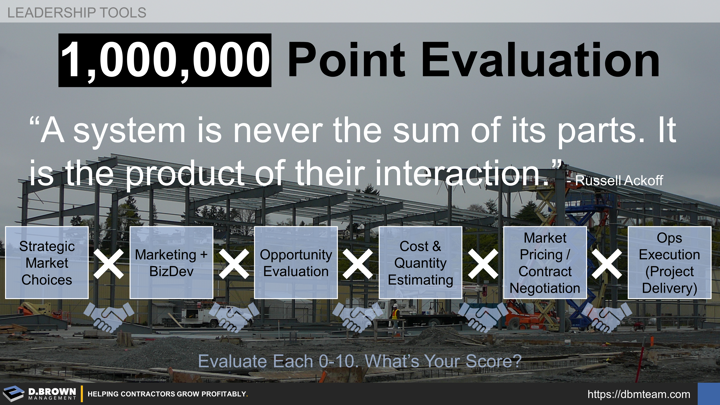"A system is never the sum of its parts. It is the product of their interaction." - Russell Ackoff
This is not meant to be a deep analysis, just a simple exercise to help you see how each of your team members sees the company. You can use it to help develop and align the team as well as improve your operations.
For each of these six factors, have them evaluate the company on a 0-10 scale and include their reasons why including examples or data where applicable.
- Strategic Market Choices: Are we positioned in market sectors that give us the best chance of winning? Prep work includes this article and video on strategy vs. planning.
- Marketing & Business Development: Are we developing enough opportunities aligned with our strategic choices, capabilities, and capacity that allow us to be selective and meet our business plan? The Truth About Business Development and The Sales Funnel.
- Opportunity Evaluation: Are we evaluating our opportunities rigorously to maximize our returns and minimize our risks?
- Cost & Quantity Estimating: Are we accurately estimating the costs and quantities based on scope, conditions, and capabilities (#6)?
- Market Pricing / Contract Negotiations: Are we setting external pricing for the project and negotiating the contractual terms to optimize returns?
- Ops Execution (Project Delivery): Are we executing our projects as estimated (#4)? See The Seven Basic Project Team Objectives.
Remember that these all work together as a system. The outcome is not a sum of the scores (max 60) but rather a product of how they all work together (max 1,000,000).
This is why it is relatively easy for well-performing contractors to consistently achieve 2-3X industry benchmarks in terms of safety, growth, profit, and cash.
Please contact us to learn more about how to use this simple subjective evaluation with your team. We will share anything we've learned that will help build stronger contractors and their teams.
An experienced but unbiased third party can be valuable for both setting up this exercise and facilitating the follow-up discussions with the team. This allows the leader to backup and deeply "observe" how their team is thinking, communicating, and interacting with each other.

